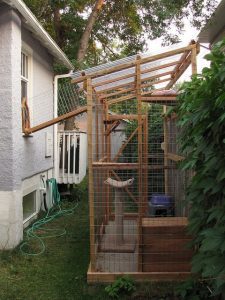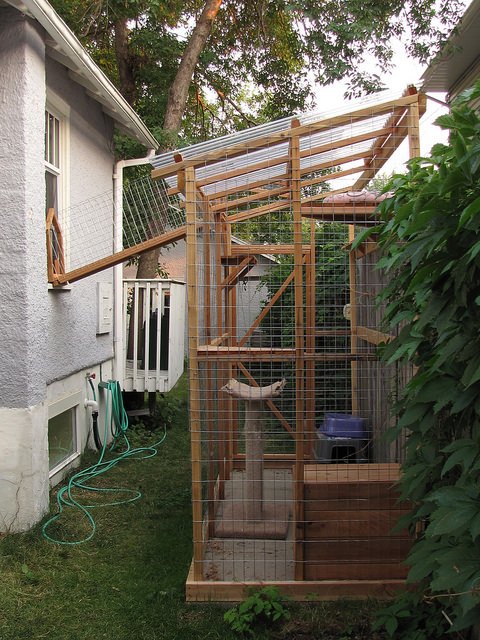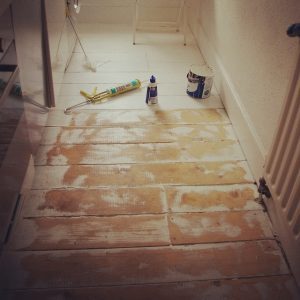An outdoor cat enclosure enriches your indoor pet’s life, allowing access to the sights, scents, and sounds of nature without putting kitty in harm’s way. A large catio can double as an outdoor seating area for people, too!
Different types of Catios for Different Living Situations
Window Catios
The simplest catios are little more than outdoor window extensions – caged in platforms that extend from a window and attach to the side of your home, allowing kitty to experience the outdoors just a bit. These window seats can be purchased as kits and installed, but with even a little bit of building know-how, you can easily put one together with some 2x4s, plywood, and woven wire or durable pet screening. A few notes on this type of catio:
- All wood components should be appropriately coated with an outdoor finish for weather resistance.
- Do not allow your cat to use this catio unless you are home and awake. A determined burglar can easily destroy a window catio and gain access to your home via an open window.
- Insects can come in if you do not use screening.
- Heat and air conditioning can escape via the open window.
- Installing a cat door in the window can help keep insects out and prevent issues with heating and cooling – but it’s not likely to do much to deter would-be burglars.

Open Air Catios
If you like, you can build a larger freestanding catio next to a window or even attached to your home via a framed, wired tunnel. This can be as simple or as complicated as you like. Framed with 2x4s or other dimensional lumber, with or without a metal or plastic roof, and furnished with plywood shelves for climbing and relaxing, this catio design can even have enough space for a chair or two.
- Draft a design for your catio. Be sure to include a “human” access door so that you can come in and out to maintain the catio and enjoy social time with your pet.
- Check local building codes before getting started. You may need a permit for this project in some areas.
- Consider building a base with pavers or concrete, to keep your pet’s area free from mud, and to prevent any need to mow the grass in the interior.
- Use sturdy materials to help keep human and animal intruders out.
Balcony Catios
If you live in an apartment or townhouse, and if your building managers or homeowners association approves, you can easily create a catio for an apartment balcony.
- Measure the area of the balcony from ceiling to floor.
- Draw a design for a frame that encompasses all open areas that could serve as potential escape routes. Keep in mind – cats can walk on narrow ledges and jump long distances! Simple materials such as 2x4s and plywood will probably suffice for the frame.
- As you create your design, be sure to incorporate enough framing to prevent the open “viewing” areas or windows from caving in. Cats love to hang from screens in their catio areas and you want to prevent accidents that could result from their activity.
- Choose your materials. You can have your local home improvement store cut them to order if needed.
- Paint or stain the framing materials as you like. Once they are dry, assemble the frame.
- Attach heavy-duty wire mesh or durable pet screening to the frame to make your enclosure complete.
Porch, Patio, and Deck Catios
Like balcony catios, designs built for porches, patios, and decks come with the advantage of having a floor and perhaps even a ceiling already in place. It’s possible to build a DIY catio for any of these areas using basic materials including dimensional lumber such as 2x4s, along with plywood, wire mesh, and screening as needed.
You can also use pre-fabricated materials such as metal dog kennel panels. If you opt for this type of design, ensure that you block all escape routes.
Since security can be an issue, be sure to add a cat door to provide your pet with easy access to the play area.
Time and Costs
How much time does it take to build a catio?
Depending on your level of expertise and the size of your project, a catio can take anywhere from a few hours to several days to build. It’s a good idea to take your time with designing the catio and measuring the area as well as the materials. If you aren’t confident with your skills in this area, you can find catio plans online, complete with measurements and supply lists.
What is the average cost of building a catio?
A simple window catio can cost less than $100 in supplies, while a larger, free standing one can come at a cost of well over $1,000. There are many variables to keep in mind, such as where you purchase your supplies and how you furnish your catio. If needed, you can spread the cost of supplies out over the course of a few months.
Furnishing and Decorating Your Catio
Your catio’s design can be spartan, or it can be luxurious. It’s all up to you! Here are a few ideas for getting started.
- Choose weatherproof items or items that can be easily laundered when considering soft cushions, etc. for your cat to lounge on. Carpet should be of an indoor/outdoor type if used.
- Save money by building custom cat trees and shelves with items such as tree limbs, baskets, and plywood. Cats love to climb, and even a small catio can become quite an exciting play area when you maximize the amount of vertical space.
- Add a litter box or two, neatly enclosed for privacy.
- Provide lots of interesting textures for your cat to enjoy.
- Ensure that you use cat-safe plants only. You can of course grow catnip for your kitty, but there are some other species that cats enjoy. Here’s a list of plants that are safe for cats and great for adding to catios, either in-ground or in planters.
- cat grass
- valerian
- friendship plant
- air plants
- prayer plant (calathea)
- Boston ferns
- lemongrass
- lace flower vine
- aluminum plant
- spider plants
- maidenhair ferns
- cat thyme
- polka dot plant
- lipstick plant
- Christmas cactus
- licorice root
- parlor palm
- mint
- African violets
- zinnias
- petunias
- asters
- cock’s comb
- roses
- marigolds
With a small amount of effort and imagination, it’s easy to build a DIY catio that your pet (and you!) will enjoy for years to come.




